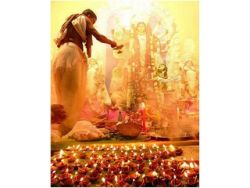
 Astro and Healer Rakesh Periwal
19th Jan 2019
Astro and Healer Rakesh Periwal
19th Jan 2019What is Aarti : Aarti is said to have plummeted from the Vedic idea of flame ceremonies, or homa. The word may likewise allude to the conventional Hindu reverential tune that is sung amid the custom. Aarti is performed and sung to build up the most elevated love for God. "Aa" signifies "towards or to" and "rati" signifies "right or goodness" in Sanskrit. Aarti is for the most part performed 2 to 5 times daily and for the most part toward the finish of a puja or bhajan session. It is performed amid every Hindu function and events. It includes the circling of an 'Aarti plate' around an individual or god and is commonly joined by the singing of tunes in acclaim of that deva or individual (numerous adaptations exist). In doing as such, the plate itself should gain the intensity of the god. The minister flows the plate to every one of those present. They glass their down-turned hands over the fire and after that raise their palms to their brow - the purificatory favoring, go from the deva's picture to the fire, have now been passed to the enthusiast. The aarti plate is commonly made of metal, typically silver, bronze or copper. On it should rest a light made of worked flour, mud or metal, loaded up with oil or ghee. A cotton wick is put into the oil and afterward lit, or camphor is singed. The plate likewise contains blooms, incense and akshata. The reason for performing arati is the waving of lit wicks previously the gods in a soul of modesty and appreciation, wherein dependable devotees progress toward becoming drenched in God's perfect frame. It symbolizes the five components: 1) space (akash), 2) wind (vayu), 3) light (tej), 4) water (jal), and 5) earth (pruthvi). Common Aarti is performed in the mandir. Notwithstanding, fans additionally perform it in their homes. Types of Aarti : Aarti for the most part regular as dhoop profound aarti yet aarti likewise are a few kinds. Aarti not just a custom just it's a piece of culture and furthermore a custom, so these kinds of aartis are make essential job in any profound love. This numerous kinds make aarti an extremely extraordinary performing workmanship likewise, yes doing aarti well ordered is a performing craftsmanship. In our day by day revere and unattractive love event we do extremely basic and short aarti its called dhoop-profound aarti however aarti likewise called panchaaarti mean aarti with 5 things, as dhoop, profound, conch water, new material and hand fan. In multi day multiple times in morning, twelve, evening, night and night we perform aarti. This isn't generally pursue a custom however its imperative to pursue a framework at this performing time. What's name of these aarti, lets think about it- · Mangal Aarti ( Morning aarti) · Puja Aarti ( After end of day worship) · Bhog Aarti ( Afternoon aarti with offering lunch meal to god) · Sandhya Aarti ( Evening aarti) · Shayan Aarti (Night aarti) Mangal Aarti ( Morning aarti) Mangala-arati starts at some point somewhere in the range of 4:00 and 4:30 a.m., when the Deity's window ornaments are opened and the Pujari blows the conch. Preceding opening the window ornament, the Pujari has stirred the Deities, offering them Balya-bhoga of morning gear, water and drain desserts or different arrangements reasonable for early morning. The supernatural sound of the conch (shankh) is blown to flag the enlivening of the Deities, who seem still wearing their night robe, without wreaths or adornments. Puja Aarti ( After end of day worship) Towards the finish of each ceremonial love (pooja or bhajan) of the Lord or to respect a regarded visitor or holy person, we play out the aarati. This is constantly joined by the ringing of the chime and at times by singing, playing of melodic instruments and applauding. It is one of the sixteen stages (shodasha upachaara) of the pooja custom. It is alluded to as the propitious light (mangla niraajanam). Holding the lit light in the correct hand, we wave in a clockwise hovering development to light the whole type of the Lord. Each part is uncovered exclusively and furthermore the whole type of the Lord. As the light is waved we either do mental or noisy reciting of supplications or just observe the delightful type of the Lord, lit up by the light. Toward the finish of the aarati we put our hands over the fire and after that tenderly touch our eyes and the highest point of the head. Bhog Aarti ( Afternoon aarti with offering lunch meal to god) Bhog mean nourishment offer for God. After offer bhog or nourishment it's called prasad. At the point when bhog offer that time aarti additionally perform and its known as bhog aarti. For the most part sanctuary and any enormous puja festivity time bhaog aarti for the most part doing. Numerous spots bhog aarti perform with just dhoop, profound or just karpoor aarti. Panchaaarti likewise perform in this bhog aarti time. Be that as it may, bhog aarti for the most part a short aarti. Bhog mean anything you offer for God, bhog isn't essansial for any puja however its piece of the love. Sandhya Aarti ( Evening aarti) Sandhya mean night time in multi day. Night is the best supplication time for any religion. In Hindu love process evening aarti is Important. At the point when the Sun set and murkiness around our tendency then we lit light (diya) and lit dhoop moreover. It is called sandhyaupasaha. Panch upchar aarti is best to even aarti yet a few houses perform dhoop-profound aarti that time moreover. In night time blessed insence smoke give a verry profound inclination and light finished the murkiness. Ringer and conch sound creat this minute sacred. Each sanctuary each house sandhya aarti performed day by day. Dhoop, profound, conch water, fabric, bloom and hand fan utilized for this sandhya aarti. For the most part tempel and math pursue this pancha and sapta aarti rule however fundamentally in home individuals like to aarti with dhoop and profound. Shayan Aarti (Night aarti) Shayan mean rest, Shayan aarti is the last aarti in multi day. When we begin multi day with aarti that called Mangal Aarti and when we end multi day with aarti that is Shayan aarti. Aarti dependably an exceptional for any piece of state and each aartli not the same as others like mangal aarti is extremely basic aarti with dhoop deeep, puja aarti simply minimal long, bhog aarti it vital aarti for multi day since it is noon and sandhy aarti is so atractive and long too this time dhoop aarti is vital piece of aarti and the end time aarti is shyayan aarti it additionally so basic with dhoop profound. This time conch move not sounded. With this aarti we ask god for rest and thanks a wonderfull day.
 Like
(0)
Like
(0)